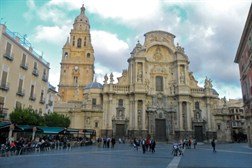Murcia
 A similar argument can be made for the city of Murcia and its cathedral. Though the reconquista of Murcia had been completed as early as the thirteenth century, the construction of the cathedral only began a century later. Initially, as happened in many other cities, the ancient Arab mosque was simply adapted to Christian worship. The work on the new church began in 1394, under Bishop Fernando de Pedrosa. Consecrated in 1465 but actually completed in 1467, the church underwent a number of changes and additions in later centuries, sometimes as result of fortuitous events such as the great fire in 1854 that destroyed the altar and the choir. The medieval origins of the building are clearly visible in the interior, a perfect example of Gothic style. The three aisles, each of different heights and with a final apse, hold the remains of many illustrious Murcians of the past, such as the writer of the seventeenth century, Diego de Saavedra FajardoDiego de Saavedra Fajardo (1584-1648) was a Spanish writer and diplomat. His most famous work is the treatise Empresas Políticas o Idea de un príncipe cristiano representada en cien empresas, (Political Exploits or the Ideal of a Christian Prince represented in one hundred exploits), published in 1640. He was secretary to Cardinal Gaspar Borgia and held important diplomatic missions. He was one of the representatives of Spain in the peace congress of Münster (1648).. What makes the cathedral of Murcia one of the most impressive examples of Baroque architecture is the outside, and especially the monumental stone façade. The previous façade, dating from the sixteenth century, was demolished following the damage caused by earthquakes and floods. The architect Jaime BortJaime Bort y Meliá (?-1754) was a Baroque sculptor and architect. His most famous work is undoubtedly the façade of the Cathedral of Murcia, rebuilt in 1737 due to repeated damage from weather and natural and extraordinary events. He died in 1754. designed a new façade resembling a large altarpiece facing the square. The construction work, which lasted from 1737 to 1754, gave birth to a perfect example of Baroque aesthetics. The big bell is the true symbol, not only of the cathedral, but of the entire city of Murcia. 98 metres high, its construction lasted almost three centuries. The third floor, in Baroque style, was erected in 1765 by the architect José López.
A similar argument can be made for the city of Murcia and its cathedral. Though the reconquista of Murcia had been completed as early as the thirteenth century, the construction of the cathedral only began a century later. Initially, as happened in many other cities, the ancient Arab mosque was simply adapted to Christian worship. The work on the new church began in 1394, under Bishop Fernando de Pedrosa. Consecrated in 1465 but actually completed in 1467, the church underwent a number of changes and additions in later centuries, sometimes as result of fortuitous events such as the great fire in 1854 that destroyed the altar and the choir. The medieval origins of the building are clearly visible in the interior, a perfect example of Gothic style. The three aisles, each of different heights and with a final apse, hold the remains of many illustrious Murcians of the past, such as the writer of the seventeenth century, Diego de Saavedra FajardoDiego de Saavedra Fajardo (1584-1648) was a Spanish writer and diplomat. His most famous work is the treatise Empresas Políticas o Idea de un príncipe cristiano representada en cien empresas, (Political Exploits or the Ideal of a Christian Prince represented in one hundred exploits), published in 1640. He was secretary to Cardinal Gaspar Borgia and held important diplomatic missions. He was one of the representatives of Spain in the peace congress of Münster (1648).. What makes the cathedral of Murcia one of the most impressive examples of Baroque architecture is the outside, and especially the monumental stone façade. The previous façade, dating from the sixteenth century, was demolished following the damage caused by earthquakes and floods. The architect Jaime BortJaime Bort y Meliá (?-1754) was a Baroque sculptor and architect. His most famous work is undoubtedly the façade of the Cathedral of Murcia, rebuilt in 1737 due to repeated damage from weather and natural and extraordinary events. He died in 1754. designed a new façade resembling a large altarpiece facing the square. The construction work, which lasted from 1737 to 1754, gave birth to a perfect example of Baroque aesthetics. The big bell is the true symbol, not only of the cathedral, but of the entire city of Murcia. 98 metres high, its construction lasted almost three centuries. The third floor, in Baroque style, was erected in 1765 by the architect José López.
